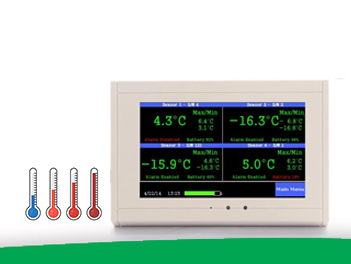
Wireless System
Pros:
- High scalability to cover an asset regardless of the size, location, and quantity under one system.
- Easier, Faster, and Cheaper to install.
- Ease of relocation of assets and migration of entire systems.
- These are generally battery operated and run even during power outages.
- Capable of delivering smart alerts such as push notification, SMS, Call, and Email alerts.
- Ease of data analysis for different parameters and date ranges.
- Backup cloud storage in cases of complete system failure.
- Independent from compatibility constraints or integration with existing systems.
- The sensors are small and can still cover effectively multiple parameters.
- Pose a less health hazard due to no use of wires and small footprint.
- Remote data viewing enables a user to be anywhere in the world and view data with an active internet connection.
- Ease of data integration linking assets even from two different continents to a single dashboard/platform.
Cons:
- Difficult to install in places with no internet availability.
- Higher preventive maintenance having more scope of failure such as low battery, poor to no signal reception, internet access, cloud downtime etc.
- Prone to interference and interruption due to other electrical devices or large walls/obstruction preventing signal to reach the receiver.
- Recurring charges year on year for taking cloud subscription services.
Wired System
Pros:
- Immune to internet failures or network disconnections in most cases.
- Being independent of RF/Wifi transmissions, there are no obstructions in transmission due to electrical interference or thick walls and similar structures.
- Low preventive maintenance tasks.
- Do not have recurring costs as compared with yearly cloud subscriptions in wireless systems.
Used intensively in BMS based systems. - Wide variety of sensors available as compared with wireless systems.
- The sensor costs are cheaper as compared with wireless system sensors.
Cons:
- Labor-intensive, time-consuming, and expensive installation.
- Scalability is very poor such as different locations, high quantity of assets, and large size of the asset(such as warehouses, high-rise building, etc) makes wiring extremely difficult.
- Relocation of assets under a wired system to a new location is a big challenge and a costly affair.
- Data loss in cases of complete system failure.
- May pose danger and cause hazard due to wiring especially in large sites where hundreds or thousands of independent wiring needs to be done.
- Localized system as data can only be viewed from one point only.
What are the Pros and Cons of Temperature recording alert systems with WiFi, Wireless, Radio Frequency and SIM card?
| Parameter | Wired system | WiFi system | Rf system | SIM card based system |
| Ease of installation | Difficult | Moderate | Moderate | Easy |
| Inbuilt memory storage of data | Available | Available | Available | May not be available |
| Alerts in case of power faiure | Yes | No | No | Yes |
| Remote monitoring in case of power failure | No | No | No | Yes |
| Remote monitoring in case of internet failure | No | No | No | Yes |
| Ease of relocation | Diffficult | Easy | Easy | Easy |
| Battery operated | No | Yes | Yes | Yes |
| SMS, Call and Email Alerts | Yes | Yes | Yes | Yes |
| Data analysis capability | Yes | Yes | Yes | Yes |
| Cloud Storage | No | Yes | Yes | Yes |
| Compatibility to 3rd party systems | Difficult | Moderate | Moderate | Easy |
| Remote Viewing | May not be available | Available | Available | Available |
| Multiple Locations integration | No | Yes | Yes | Yes |
| BMS compatible | Yes | No | No | No |
| Internet failure impact | No | Yes | Yes | No |
| Electrcial Interference | No | Yes | Yes | Yes |
| Preventive maintenance frequency | Low | Medium | Medium | Medium |
| Yearly subscription costs | No | Yes | Yes | Yes |
| Chances of posing hazard onsite | Medium | Low | Low | Low |
| Installation footprint | High | Low | Medium | Low |
| Variety of sensors | High | Medium | Medium | Low |
